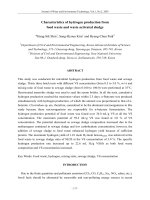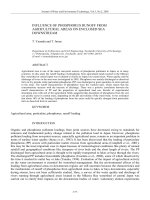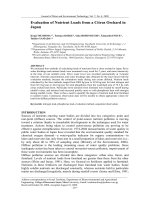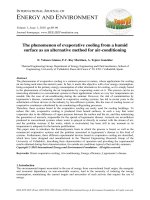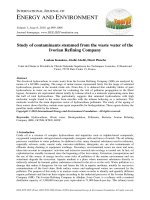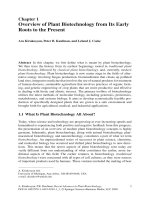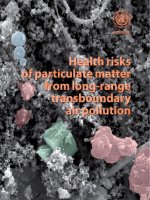- Trang chủ >>
- Khoa Học Tự Nhiên >>
- Vật lý
preparation of hexagonal wo3 from hexagonal ammonium tungsten bronze for sensing nh3
Bạn đang xem bản rút gọn của tài liệu. Xem và tải ngay bản đầy đủ của tài liệu tại đây (673.32 KB, 4 trang )
Preparation of hexagonal WO
3
from hexagonal ammonium tungsten bronze
for sensing NH
3
Imre Miklo
´
s Szila
´
gyi
a,
*
, Lisheng Wang
b
, Pelagia-Irene Gouma
b
, Csaba Bala
´
zsi
c
,Ja
´
nos Madara
´
sz
d
,
Gyo
¨
rgy Pokol
d
a
Materials Structure and Modeling Research Group of the Hungarian Academy of Sciences, Budapest University of Technology and Economics, H-1111 Budapest, Szt. Gelle
´
rt te
´
r4,
Hungary
b
Department of Materials Science and Engineering, 314 Old Engineering Building, SUNY, Stony Brook, NY 11794-2275, USA
c
Ceramics and Nanocomposites Laboratory, Research Institute for Technical Physics and Materials Science, H-1121 Budapest, Konkoly-Thege u
´
t 29-33, Hungary
d
Department of Inorganic and Analytical Chemistry, Budapest University of Technology and Economics, H-1111 Budapest, Szt. Gelle
´
rt te
´
r 4, Hungary
1. Introduction
As sensors to various gases (NH
3
,NO
2
,H
2
S, etc.) [1–3],
chromogenic (electro-, photo- and thermochromic) materials
[4–6] and catalysts in several acid-catalysed [7] or photocatalytic
[8] reactions, tungsten oxides are attracting continuous attention.
Among a series of polymorphs of tungsten oxides, the
hexagonal phase, h-WO
3
has drawn special interest due to its
open-tunnel structure and intercalation chemistry, which is quite
different from ReO
3
-like stable phases. The h-WO
3
is usually
prepared by acidification and hydrothermal treatment (with
various promoting reactants) of alkali tungstates [9–13]. However,
since a hydrothermal step is involved, the small dimension of
autoclaves used for research purposes limits the yield of h-WO
3
powders. In addition, these methods are time consuming because
the hydrothermal reaction can take hours or days, and very often
calcination is needed to obtain crystalline products.
Besides wet chemical methods, thermal annealing of ammo-
nium polytungstates [14,15] or hexagonal ammonium tungsten
bronzes [16,17] is also a viable way to prepare h-WO
3
.Thislatter
route has the advantage that it requires less time and larger
batches of h-WO
3
can be produced. However, it must be
mentioned that t hermal annealing yields a h-WO
3
structure,
whi ch is not comp letely the same as t he one produced by
hydrothermal synthesis. This is shown by that the differently
produced h-WO
3
samples have different XRD reference cards:
ICDD 33-1387 and 75-2187 for h- WO
3
prepared hydrothermally
and ICDD 85-2460 for h-WO
3
prepared by thermal annealing.
Neverthel ess, a comparison of the published atomic coordinates
[10,14] of these differently prepared h-WO
3
samples show that
the structures are basically the same (i.e. both are built up by
corner sharing octahedra, which form hexagonal and trigonal
channels along the c-axis), and the differences between them are
minor. Therefore the application characteristics of the h-WO
3
samplespreparedbythesetwowaysshouldnotdifferfromeach
other significantly.
Up to now, among the several application possibilities of h-WO
3
prepared by thermal annealing, only the ion intercalation was
studied [14,16]. However, as gas sensors they were not tested and
it was still unknown whether thermal annealing of ammonium
polytungstates and hexagonal ammonium tungsten bronzes could
yield nanosize h-WO
3
.
Materials Research Bulletin 44 (2009) 505–508
ARTICLE INFO
Article history:
Received 3 June 2008
Received in revised form 2 July 2008
Accepted 5 August 2008
Available online 12 August 2008
Keywords:
A. Oxides
Semiconductors
C. X-ray diffraction
Electron microscopy
D. Electrical properties
ABSTRACT
Hexagonal tungsten oxide (h-WO
3
) was prepared by annealing hexagonal ammonium tungsten bronze,
(NH
4
)
0.07
(NH
3
)
0.04
(H
2
O)
0.09
WO
2.95
. The structure, composition and morphology of h-WO
3
were studied
by XRD, XPS, Raman,
1
H MAS (magic angle spinning) NMR, scanning electron microscopy (SEM), and BET-
N
2
specific surface area measuremen t, while its therm al stability was investigated by in situ XRD. The h-
WO
3
sample was built up by 50–100 nm particles, had an average specific surface area of 8.3 m
2
/g and
was thermally stable up to 450 8C. Gas sensing tests showed that h-WO
3
was sensitive to various levels
(10–50 ppm) of NH
3
, with the shortest response and recovery times (1.3 and 3.8 min, respectively) to
50 ppm NH
3
. To this NH
3
concentration, the sensor had significantly higher sensitivity than h-WO
3
samples prepared by wet chemical methods.
ß 2008 Elsevier Ltd. All rights reserved.
* Corresponding author. Tel.: +36 1 463 4047; fax: +36 1 463 3408.
E-mail address: (I.M. Szila
´
gyi).
Contents lists available at ScienceDirect
Materials Research Bulletin
journal homepage: www.elsevier.com/locate/matresbu
0025-5408/$ – see front matter ß 2008 Elsevier Ltd. All rights reserved.
doi:10.1016/j.materresbull.2008.08.003
Recently we managed to prepare hexagonal ammonium
tungsten bronze (HATB), (NH
4
)
0.07
(NH
3
)
0.04
(H
2
O)
0.09
WO
2.95
by
heating ammonium paratungstate tetrahydrate (APT),
(NH
4
)
10
[H
2
W
12
O
42
]Á4H
2
OinH
2
for 6 h at 400 8C [18]. This has
allowed us to synthesize h-WO
3
in good quality from this HATB
sample and study its gas sensitivity.
In this paper, h-WO
3
particles were successfully prepared in
large batch and short time by heating the HATB precursor. The
structure, composition and morphology of the product were
studied by powder XRD, XPS, Raman,
1
H MAS (magic angle
spinning) NMR and scanning electron microscopy (SEM), while its
thermal stability was investigated by in situ high temperature
powder XRD. Gas sensing layer was prepared from as-produced h-
WO
3
, and its sensitivity was tested to NH
3
.
2. Experimental
Sample h-WO
3
was prepared by heating HATB,
(NH
4
)
0.07
(NH
3
)
0.04
(H
2
O)
0.09
WO
2.95
in air (15 l h
À1
)at108C min
À1
to 470 8C and then keeping it there isothermally for 3 min in an
open aluminium crucible in a Du Pont 910 DSC instrument. To
check the reproducibility of this preparation route, several batches
of h-WO
3
were prepared, and it was found that the characteristics
of different h-WO
3
batches did not differ from each other. Since it
was enough for research purposes, usually 1 g of powder was
produced in a batch, but the batch size can be increased easily.
Therefore it was demonstrated that – compared to the common
wet chemical methods – this preparation route of h-WO
3
required
less time (1 h or even less), was reproducible, and could yield large
batches of h-WO
3
.
Powder X-ray diffraction (XRD) pattern of h-WO
3
was
measured by a PANalytical X’pert Pro MPD X-ray diffractometer
equipped with an X’Celerator detector using Cu K
a
radiation. In
situ high temperature XRD patterns of h-WO
3
in static air were
collected by the same X-ray diffractometer in an Anton Paar HTK-
2000 high temperature XRD chamber using Cu K
a
radiation. The
scanning time was ca. 3 min for each pattern and the heating rate
was 10 8C min
À1
between XRD measurements.
X-ray Photoelectron Spectroscopy (XPS) spectra were recorded
by a VG Microtech instrument consisting of a XR3E2 X-ray source, a
twin anode (Mg K
a
and Al K
a
) and a CLAM 2 hemispherical
analyser using Mg K
a
radiation. Detailed scans were recorded with
50 eV pass energy at (0.05 eV/1.5 s). The spectrometer was
calibrated with the binding energy of the C1s line (284.5 eV).
Raman spectra were collected by a Jobin Yvon Labram
instrument attached to an Olympus BX41 microscope. Frequency
doubled Nd-YAG laser (532 nm) was applied as exiting source with
1 mW applied power. The sample was located and examined with a
50Â objective, thus individual crystals could be examined (laser
spot size was about 1.2
m
m). The backscattered light collected by
the objective was dispersed on an 1800 g/mm grating and detected
by a 1024 Â 256 CCD detector.
1
H MAS NMR experiments were carried out on a VARIAN NMR
SYSTEM spectrometer (600 MHz for
1
H) using a 3.2 mm HXY
VARIAN/Chemagnetics probe.
1
H chemical shifts were referenced
to adamantane (
d
1H
= 0 ppm). Spectra were recorded under the
same experimental conditions. 16 transients were acquired at
12 kHz spinning rate and a recycle delay of 20 s was used.
Background suppression DEPTH [19] was employed to remove
signals from the probe.
Scanning electron microscopy (SEM) characterization was
performed by a LEO-1550 FEG SEM instrument.
BET specific surface area measurement was carried on by
nitrogen adsorption at 77 K (Micromeritics Gemini 2375) after
degassing the sample, at least, for 1 h at 150 8C in nitrogen.
For gas sensing test, as-synthesized h-WO
3
particles were well
grinded into powders. The gas sensing layer was produced by spin
coating 10 mg powder/5 ml n -butanol suspension of h-WO
3
on
Al
2
O
3
substrates with Au-metallization. Sensing tests were carried
out in the gas flow bench set-up at SUNY, Stony Brook. The gases
used in the sensing setup were UHP nitrogen (Praxair), UHP oxygen
(Praxair), 1000 ppm ammonia in nitrogen (BOC gases). Concentra-
tion of ammonia was varied by varying its flow rate in conjunction
with nitrogen/oxygen flow rates.
3. Results and discussion
Based on the XRD pattern (Fig. 1), the h-WO
3
sample was
identified as pure h-WO
3
(ICDD 85-2460) with a well ordered
crystalline structure. Its cell parameters (a = 0.7324 nm and
c = 0.7638 nm) were almost the same as the ones published by
Oi et al. [14].
The Raman bands [20–22] were also typical to h-WO
3
(Fig. 2).
The main bands at 783, 692, 648 cm
À1
were characteristic O–W–O
stretching vibrations. The bands at 325, 300 and 264 cm
À1
could be
assigned to O–W–O deformation vibrations. The band at 456 cm
À1
was related to a small amount of reduced W atoms. The peak at
184 cm
À1
was a lattice mode of h-WO
3
. In contrast with the h-WO
3
sample, the precursor HATB contained a significant amount of
reduced W atoms (see XPS results below). As a consequence the
absorption bands were very broad in the Raman spectrum of HATB.
Fig. 1. XRD pattern of h-WO
3
.
Fig. 2. Raman spectra of (a) HATB; (b) h-WO
3
.
I.M. Szila
´
gyi et al. / Materials Research Bulletin 44 (2009) 505–508
506
The oxidation state of tungsten atoms was investigated by XPS.
Since HATB was partly reduced, W
4+
(5.4%) and W
5+
(13.8%) atoms
were also observed besides W
6+
(80.9%) atoms [18]. When HATB
was heated in air at 470 8C, the product h-WO
3
showed an almost
fully oxidized structure (96.8% W
6+
, 1.8% W
5+
, 1.4% W
4+
). This was
also supported by the yellow color of h-WO
3
, while the partly
reduced HATB was dark blue.
We measured the amount of NH
4
+
ions and NH
3
molecules,
which remained in the solid structure, by solid-state
1
H MAS NMR
spectroscopy [18]. After curve fitting the
1
H MAS NMR spectra, the
peaks at 4.5 and 5.6 ppm were assigned to NH
4
+
ions and NH
3
molecules respectively. The
1
H MAS NMR results showed that the
amount of NH
4
+
ions and NH
3
molecules decreased significantly in
h-WO
3
compared to HATB, but they were still present. Recently we
determined the amounts of NH
4
+
and NH
3
in h-WO
3
, which were
ca. 0.11 and 0.04 wt.%, respectively [17].
The morphology of h-WO
3
was investigated by SEM. The
precursor of h-WO
3
, i.e. HATB was built up by aggregated 50–
100 nm particles (Fig. 3a). The annealing of HATB did not affect the
morphology significantly. Therefore the h-WO
3
sample was also
built up by 50-100 nm particles, which were aggregated into
m
m
scale blocks (Fig. 3b and c).
BET measurement showed that the average specific surface area
(SSA) of the particles was about 8.3 m
2
/g and the BET equivalent
average diameter (d
BET
) was 100 nm, which is consistent with
above SEM results. Here, d
BET
is calculated as d
BET
= 6/(SSA Â
r
p
),
where
r
p
is the weighted density of h-WO
3
(7.16 g/cm
3
).
For gas sensing tests it was advisable to study the thermal
stability of h-WO
3
. Based on in situ high temperature XRD patterns
(Fig. 4), the starting h-WO
3
structure remained nearly the same up
to 450 8C. Then between 500–550 8C the hexagonal structure
transformed irreversibly into monoclinic (m-) WO
3
(ICDD 43-
1035), which later around 750 8C transformed reversibly into
tetragonal (t-) WO
3
(ICDD 85-0807). Thus, in situ XRD study
showed that h-WO
3
was stable up to 450 8C [17], which made it
safe to test h-WO
3
at 300 8C as a gas sensor.
The sensing response of the h-WO
3
layer to different
concentrations of NH
3
gas is shown in Fig. 5. The measurements
were carried out at 300 8C. The film showed a decrease in
resistance on exposure to NH
3
, which is characteristic to an n-type
semiconductor. If we define the sensitivity as the ratio of baseline
resistance to gas-responding resistance, its value was 2 when the
NH
3
concentration was 10 ppm. When we increased NH
3
concentration to 20 ppm and 50 ppm step by step, the sensitivity
increased to 4 and 6, respectively. This means the h-WO
3
sensor is
quite sensitive to different concentrations of NH
3
gas at 300 8C; in
fact, it is much more sensitive than h-WO
3
prepared by the
hydrothermal route, which had a sensitivity of 3 for 50 ppm NH
3
at
300 8C [23]. Besides, the response time was quite fast (3.3, 1.5,
1.3 min for 10, 20 and 50 ppm NH
3
, respectively), especially when
the NH
3
concentration went higher. As the NH
3
concentration
lowered down afterwards, the sensor resistance increased
gradually accordingly. It is clear to see that the sensor had almost
the same resistance value at the same NH
3
level as the first half part
Fig. 3. SEM images of (a) HATB; (b and c) h-WO
3
.
Fig. 4. In situ high temperature XRD patterns of h-WO
3
in static air recorded from
r.t. to 900 8C.
I.M. Szila
´
gyi et al. / Materials Research Bulletin 44 (2009) 505–508
507
of the test, respectively. This means the sensor performance is
reversible and recoverable, which is important for its application.
In addition, the recovery time was not long (9.0, 6.0, 3.8 min for 10,
20 and 50 ppm NH
3
, respectively). At the end of the test, the sensor
went to its baseline value when we stopped the NH
3
gas flow.
4. Summary and conclusions
h-WO
3
was prepared by annealing hexagonal ammonium
tungsten bronze, (NH
4
)
0.07
(NH
3
)
0.04
(H
2
O)
0.09
WO
2.95
. Compared to
the common wet chemical methods, this preparation route required
less time, it was reproducible, and it could yield large batches of h-
WO
3
. The as-produced h-WO
3
was pure and had a well-ordered
crystalline structure. It contained small amounts of reduced
tungsten atoms, as well as residual NH
4
+
ions and NH
3
molecules.
The h-WO
3
sample was built up by aggregated 50–100 nm particles
and was thermally stable up to 450 8C. Gas sensing layers were
prepared from as-produced h-WO
3
, and the gas sensor test showed
that h-WO
3
was sensitive to various levels (10–50 ppm) of NH
3
.Its
sensitivity to 50 ppm NH
3
(6) was significantly higher than the
sensitivity (3) of h-WO
3
samples prepared by hydrothermal
synthesis. The sensor had the fastest response and recovery times
(1.3 and 3.8. min, respectively) also for 50 ppm NH
3
. Therefore, it
was demonstrated that this preparation route resulted in a h-WO
3
sample whose gas sensing parameters were twice better than those
h-WO
3
samples, which were prepared by wet chemical methods. In
addition, this route required less time, it was reproducible, and large
batches of h-WO
3
could be obtained.
Acknowledgments
A.L. To
´
th (Research Institute for Technical Physics and
Materials Science, H ungarian Academy of Sciences, Budapest,
Hungary), A. Szabo
´
(Department of Organic Chemistry and
Technology, Budapest University of Technology and Economics,
Budapest, Hungary), K. Varga-Josepovits (Department of Atomic
Physics, Budapest University of Technology and Economics,
Budapest, Hungary) as well as P. Kira
´
ly and G. Ta
´
rka
´
nyi (Institute
of Structural Chemistry, Chemical Research Center of the
Hungarian Academy of Sciences, Budapest, Hungary) are
acknowledged for their help in performing the SEM, Raman,
XPS and
1
H MAS NMR measurements, respectively. We are also
thankful to Particle Technology Laboratory in ETH Zurich,
Switzerland for providing BET surface analysis equipment. A
diffractometer purchase grant from the Agency for Research Fund
Management (KPI-EU-GVOP-3.2.1 2004-04-0224/3.0 KMA) is
gratefully acknowledged.
References
[1] S. Ashraf, C.S. Blackman, R.G. Palgrave, I.P. Parkin, J. Mater. Chem. 17 (2007)
1063.
[2] E.H. Espinosa, R. Ionescu, E. Llobet, A. Felten, C. Bittencourt, E. Sotter, Z. Topalian, P.
Heszler, C.G. Granqvist, J.J. Pireaux, X. Correig, J. Electrochem. Soc. 154 (2007)
J141.
[3] J. Polleux, A. Gurlo, N. Barsan, U. Weimar, M. Antonietti, M. Niederberger, Angew.
Chem. Int. Ed. 45 (2006) 261.
[4] T. Todorovski, M. Najdoski, Mater. Res. Bull. 42 (2007) 2025.
[5] D.Y. Lu, J. Chen, H.J. Chen, L. Gong, S.Z. Deng, N.S. Xu, Appl. Phys. Lett. 90 (2007)
041919.
[6] S. Wang, X. Feng, J. Yao, L. Jiang, Angew. Chem. Int. Ed. 45 (2006) 1264.
[7] M.M. Natile, F. Tomaello, A. Glisenti, Chem. Mater. 18 (2006) 3270.
[8] T. Kim, A. Burrows, C.J. Kiely, I.E. Wachs, J. Catal. 246 (2007) 370.
[9] C. Bala
´
zsi, L. Wang, E.O. Zayim, I.M. Szila
´
gyi, K. Sedlackova, J. Pfeifer, A.L. To
´
th, P I.
Gouma, J. Eur. Ceram. Soc. 28 (2008) 913.
[10] B. Gerand, G. Nowogrocki, J. Guenot, M. Figlarz, J. Solid State Chem. 29 (1979) 429.
[11] Y. Oaki, H. Imai, Adv. Mater. 18 (2006) 1807.
[12] Z. Gu, Y. Ma, W. Yang, G. Zhang, J. Yao, Chem. Commun. (2005) 3597.
[13] Z. Gu, H. Li, T. Zhai, W. Yang, Y. Xia, Y. Ma, J. Yao, J. Solid State Chem. 180 (2007) 98.
[14] J. Oi, A. Kishimoto, T. Kudo, M. Hiratani, J. Solid State Chem. 96 (1992) 13.
[15] W. Han, M. Hibino, T. Kudo, Solid State Ionics 128 (2000) 25.
[16] B. Schlasche, R. Scho
¨
llhorn, Rev. Chim. Miner. 19 (1982) 534.
[17] I.M. Szila
´
gyi, J. Pfeifer, C. Bala
´
zsi, A.L. To
´
th, K. Varga-Josepovits, J. Madara
´
sz, G.
Pokol, J. Therm. Anal. Calorim 94 (2008) 499.
[18] I.M. Szila
´
gyi, F. Hange, J. Madara
´
sz, G. Pokol, Eur. J. Inorg. Chem. 17 (2006) 3413.
[19] D.G. Cory, W.M. Ritchey, J. Magn. Reson. 80 (1988) 128.
[20] M.F. Daniel, B. Desbat, J.C. Lassegues, B. Gerand, M. Figlarz, J. Solid State Chem. 67
(1987) 235.
[21] C. Santato, M. Odziemkowski, M. Ulmann, J. Augustynski, J. Am. Chem. Soc. 123
(2001) 10639.
[22] C.V. Ramana, S. Utsunomiya, R.C. Ewing, C.M. Julien, U. Becker, J. Phys. Chem. B
110 (2006) 10430.
[23] J.P. Wang,, C. Bala
´
zsi, I.M. Szila
´
gyi, P.I. Gouma, Proc. SPIE 6769 (2007) 67690E,
doi:10.1117/12.736679.
Fig. 5. Sensitivity of h-WO
3
to various levels of NH
3
at 300 8C.
I.M. Szila
´
gyi et al. / Materials Research Bulletin 44 (2009) 505–508
508

